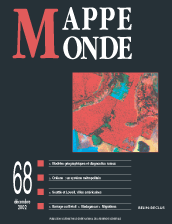

![]() Vincent Piveteau, Sylvie Lardon. Choremes and territorial diagnosis: a training experiment (7 fig.)
Vincent Piveteau, Sylvie Lardon. Choremes and territorial diagnosis: a training experiment (7 fig.)
Territorial diagnosis is now an essential phase in territorial public policies. Practitioners need to learn spatial reasoning, which requires four aptitudes: an ability to translate the phenomena, to identify the underlying models, to relate activities and spaces to each other, and to assess spatial organisation. Graphic modelling provides a foundation for this learning, trialled in training sessions in regional planning for engineers.
keyword: MODELS, SPATIAL REASONING, TERRITORY, TRAINING
![]() Choremes as a tool for analysing the needs of land managers (1 fig.)
Choremes as a tool for analysing the needs of land managers (1 fig.)
The construction of a spatial framework of reference common to different land managers requires a harmonization of definitions and techniques for demarcating the territories on which they work or intend to work. To this end, choremes can facilitate the modelling of land managers' perceptions and needs, which are often complex. They can be used to identify the structures and processes that best represent the interests of the institutions involved in land management.
keyword: CHOREMES, COMMON SPATIAL FRAMEWORK OF REFERENCE, LAND MANAGERS, LAND REPRESENTATIONS
![]() From the commune to the region: example of the Langres-Châtillonais plateau (4 fig.)
From the commune to the region: example of the Langres-Châtillonais plateau (4 fig.)
Graphic modelling is a good way to show the interrelation between an incorporated level of territorial organisation, here the commune (municipality), and an incorporating level of territorial organisation, here the level of the region. Graphic modelling is then used as a tool for representation. The example presented here is the Langres-Châtillonnais plateau.
keyword: GRAPHIC MODELLING, MODEL AGGREGATION, MORPHO-HISTORICAL MODEL
![]() Use of spatial models in agriculture teaching: farm evaluation and the environment (5 fig.)
Use of spatial models in agriculture teaching: farm evaluation and the environment (5 fig.)
A teaching method for identifying the impact of farming practices on the environment was devised based on a spatial approach. It combines in an original way various tools borrowed from geographers: landscape evaluation, use and construction of maps and adaptation of the choremes method to the scale of a farm. Using the method, students list the territorial implications of farming, identify farming practices and their environmental impact, then localise this impact on the territory of a farm.
keyword: EDUCATION, ENVIRONMENT, FARMING, SPATIAL ORGANISATION
![]() Environmental impact of the Porto Primavera hydroelectric plant (Brazil) (6 fig.)
Environmental impact of the Porto Primavera hydroelectric plant (Brazil) (6 fig.)
The construction of the Porto Primavera hydroelectric plant on the course of the upper Paraná in southern-central Brazil has brought major changes to the environment and spatial organisation. The scale and speed of the changes are particularly suited to monitoring by remote sensing. Landsat imagery shows that the construction of the dam has given a new impetus to regional economic development.
keyword: BRAZIL, ENVIRONMENTAL IMPACT , LANDSAT, LANDSCAPE, RIO PARANA
![]() Geographies of an American city in industrial history: Lowell in chronographic models (1 fig.)
Geographies of an American city in industrial history: Lowell in chronographic models (1 fig.)
Chronographic models on a medium scale offer a spatialisation of the city of Lowell (Massachusetts) over two centuries of industrial history. They show successive spatial systems that can be transposed to many industrialised regions of the economically developed world.
keyword: CHRONOGRAPHIC MODEL, INDUSTRY, LOWELL, SPATIALISATION, SPATIAL SYSTEM, UNITED STATES
![]() Seattle: the ambitious development of a discreet metropolis (8 fig.)
Seattle: the ambitious development of a discreet metropolis (8 fig.)
Despite its status as one of the most attractive metropolises in the United States, Seattle remains relatively unknown. Reputed for its quality of life and dynamic economy, the case of Seattle proves that even an American city affected by urban sprawl can attempt to control urban growth and develop a new form of governance thus demonstrating that sustainable development can be a reality.
keyword: METROPOLISATION, SEATTLE, SUSTAINABLE DEVELOPMENT, URBAN GROWTH
![]() Orléans: part of a metropolitan system (6 fig.)
Orléans: part of a metropolitan system (6 fig.)
Capital of the Centre region of France, Orléans combines high-tech industries and strategic services (research, head offices, higher education institutions). Orléans is not just a periphery, but is now integrated functionally into the Parisian metropolitan system. For the past 30 years, it has ranked among the most favoured French towns in terms of population growth and unemployment rate.
keyword: HEAD OFFICES, METROPOLISATION, ORLEANS, TECHNOPOLE, URBAN PLANNING
![]() Book reviews (Roget Brunet, Gilles Fumey, Cécile Gaudin)
Book reviews (Roget Brunet, Gilles Fumey, Cécile Gaudin)
Mappemonde 3/02![]()
![]() Mappemonde 1/03
Mappemonde 1/03
For subscribe or buy this issue: BELIN
Last modified: November 13, 2002